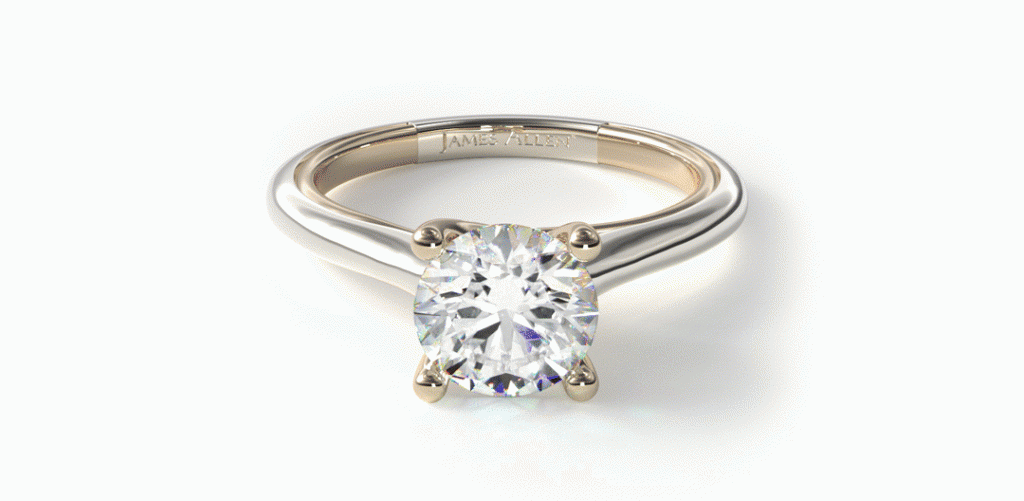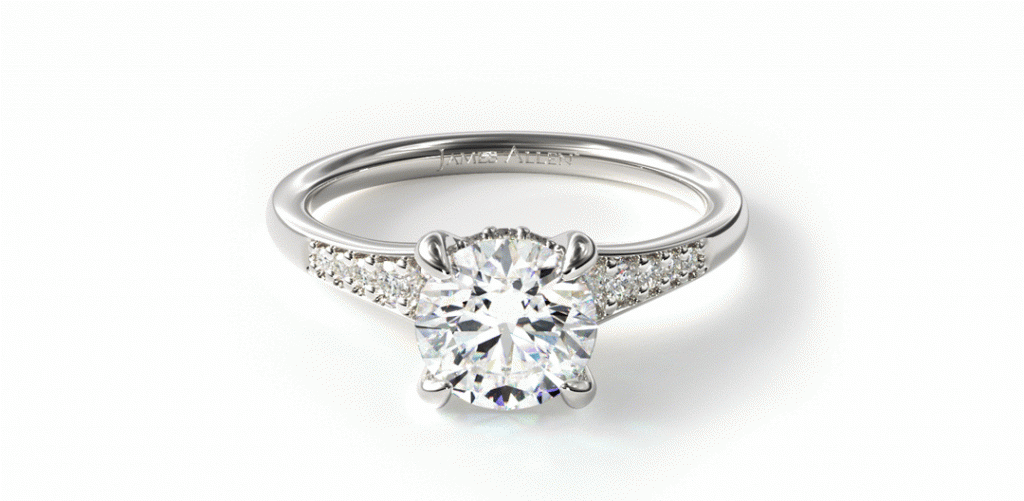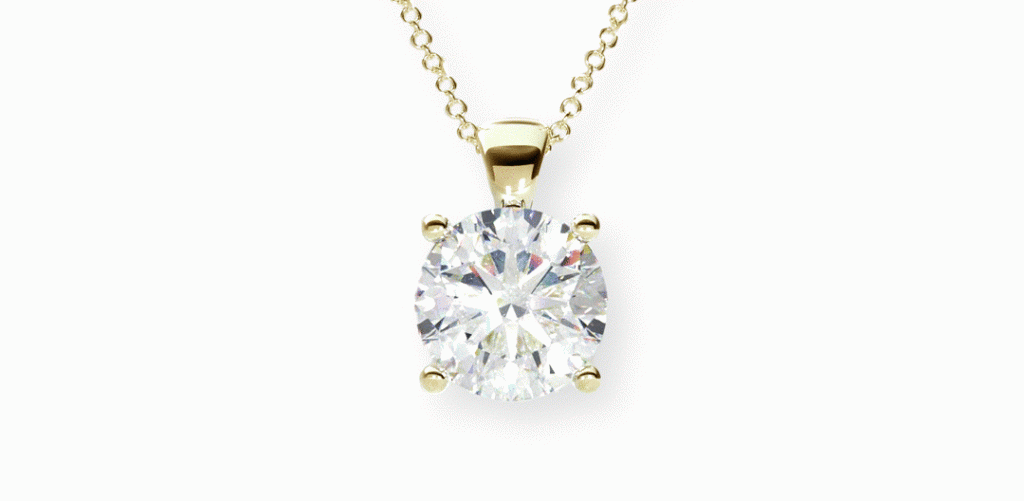
Close

July 14, 2020 | by Rachel Hoar
Lab-grown diamond – or earth-created diamond? Here’s all the data you need to live your best sparkling life.

Lab-grown diamonds are pretty much the new kids on the jewelry block. So let’s clarify a few points, so you can decide with 100% confidence which sort of sparkle sets a twinkle in your eye: classic earth-created diamonds, or cutting-edge lab-grown diamonds.
The only difference between the two is their origin.
Earth-created diamonds: sourced from below the earth’s surface.
Lab-created diamonds: created in simulated “below-ground” conditions in a lab.
What’s a diamond? It’s just carbon atoms. But arrange them in a very particular structure, and you get the incredibly hard and beautiful stone we know and love. Producing this special carbon arrangement in nature demands conditions that are…intense. We’re talking high heat and super high pressure. Needless to say, very few places in the world are capable of producing earth-created diamonds.
But technology has advanced to the point that we don’t always have to go digging for our precious stones; we can actually simulate the necessary extreme conditions in specialized pressure chambers in a lab. Lab-created diamonds are grown from tiny carbon “seeds” that develop in these chambers over months, as incredibly hot gases deposit carbon atom-by-atom onto the original seed.
Lab-created diamonds even develop their own unique characteristics (inclusions, clarity, etc) along the way, and once they’re fully grown they’re cut into the shape that suits their qualities best.


Lab-grown diamonds are generally about 30% more affordable than earth-created diamonds.
Why?
The diamond-growing process is less resource-intensive than the diamond-mining process. It simply costs less to grow a diamond in a lab than it does to mine a diamond from the earth, and those savings are passed along to diamond-shoppers. That means that for the same cost, you can purchase a lab-created diamond that’s 30% larger than an earth-created one.


Earth-created diamonds are the classic choice. Lab-created diamonds are the fresh choice.
There is no doubt that earth-created diamonds contain millennia of history, tradition, and romance. They are one of nature’s most incredible products. Drawn from deep within the earth, these sparkling treasures have been proudly flaunted by generations upon generations – paving the way for you to carry on the tradition.
Lab-created diamonds, on the other hand, are the next step in diamond history. Technically speaking, they’re brand new. But traditionally speaking, diamonds are diamonds forever. Lab-created diamonds give their wearer a unique chance to create new memories.
Both earth-created diamonds AND lab-created diamonds hold their sparkle forever, so they’ll be just as beautiful when you’ll pass them on as heirlooms as they are when you wear them on a night out.


Both earth-created and lab-created diamonds are available in nearly every shape and color – even fancy colors!
Colorful diamonds, like canary yellow ones, are quite rare. Their shocking hues are caused by trace amounts of non-carbon elements, like nitrogen. By adding these elements to a growing diamond in its pressure chamber, lab-grown diamonds take on the same fancy colors as earth-created diamonds.
Good news: any diamond can be cut into any shape. When it comes to diamond cuts, you truly are spoiled for choice!


Diamonds aren’t only for rings. Have a look at the pendants and earrings that can be set with either earth-created or lab-grown diamonds:




March 25, 2020
By Nicholas Del Re

Laboratory-grown diamonds created through chemical vapour deposition (CVD) and high pressure, high temperature (HPHT) processes are grown by a number of manufacturers who specialize in this field.
As these gemstones continue to find their place on the market, it is becoming increasingly important for retailers, designers, and other jewellery professionals to have reliable methods of detecting CVD diamonds from those that are natural—especially when the gem-cut end product of CVD crystals is visually the same as those of their natural counterparts. Disclosing the true origin of growth for diamonds, whether natural or created in a laboratory, is necessary to maintaining trust with customers and clients.
Fortunately, if one knows what to look for, subtle differences are indeed present between these two types of diamonds. Whether loose or in jewellery, CVD and HPHT laboratory-grown diamonds are detected and separated through rigorous process at Gemological Science International’s (GSI’s) laboratories; the use of carefully selected instruments by experienced staff members generate visual and spectral information that allows for this detection and separation.
When it comes to differentiating CVD and HPHT laboratory-grown diamonds from those that are natural, one of the most certain methods of separation is done through a combination of visual observations and photoluminescence.
Visual observations are achieved by using an imaging instrument, known as the DiamondView, which brings out structural growth characteristics and differences, along with variances in colouration.
This involves placing a diamond in an enclosed chamber while it is exposed to high-energy ultraviolet (UV) rays. Among the reactions seen are two kinds of luminescence called fluorescence and phosphorescence.
To give one an idea of the lower to higher energies used to excite the diamond by UV light, these are respectively: longwave (LW), shortwave (SW), and DiamondView (DV), with the wavelengths in nanometres (nm) as follows:
LW=365nm SW=254nm DV≈225nm
Fluorescence is the luminescence seen while being excited by UV light, while phosphorescence is luminescence seen occurring after the excitation of the UV light is cut off.

The telltale signs for differentiation of natural and laboratory-grown are from the colouration and appearance of structural features within the body of the diamond.
The other important test related to detecting and separating involves Raman instrumentation, which uses lasers that emit light at specific wavelengths. These are used to excite the internal atomic structure of the diamonds that, essentially, excite defects within the crystalline structure. This excitation results as photoluminescence; light emission from any form of matter after the absorption of energy, resulting in graphs that exhibit peaks which reflect the defects, and another peak that verifies it is a diamond. This, along aforementioned imaging, greatly helps one to differentiate natural diamonds from those that have been grown in a laboratory.
While performing these tests in GSI’s New York laboratory, researchers observed an unusual feature exhibited by a CVD laboratory-grown diamond.
The stone in question weighed more than two carats and was near colourless in full-spectrum daylight lighting. When placed in the DiamondView, the initial results were as expected for a laboratory-grown CVD diamond.
The resulting fluorescence exhibited a green to blue colouration (Figures 1 to 3). The different degree of colouration observed was the result of variable exposure to the UV it was subjected to. Also, the characteristic placement of colour in the structure seen was due to the growth process involved for CVD diamonds.
In addition to fluorescence, blue phosphorescence (Figure 4) was also observed.
These observations are fairly standard when viewing these diamonds under this condition; however, CVD diamonds can exhibit other phenomena under this or similar circumstances.
This brings us to a most interesting aspect of this particular CVD stone: it exhibited an unusual and dramatic change in colour after being taken out of the DiamondView instrument, going from near colourless to blue (Figure 5).
While the body colour of CVD diamonds is stable when viewed in daylight under normal conditions, it is known the colour may change if the conditions are altered (i.e. if the stone is exposed to UV light or heat). In these cases, however, the colour typically returns to its actual colour within 30 minutes to an hour of being in normal conditions and after direct exposure to full spectrum daylight lighting.
In regards to longwave and shortwave UV exposure, colour change is comparatively subtle, but becomes more dramatic as exposure and energy increase.
Although the colour of the CVD diamond reverts back to a normal stable colour, there are some caveats to be aware of. First off, while direct full spectrum lighting (e.g. a light box, preferably lacking or having minor UV radiation) would bring back the CVD diamond’s colour after about one hour, it would take two-and-a-half hours before this stone would start to return to its stable colour in an environment with standard ambient light conditions. (As a note: one should be mindful of the lighting environments that may vary in standard room-lit environments where gemstones are handled and viewed.)

The experiment continued once the colour changed to blue. The CVD stone was stored in parcel paper (read: a dark environment) for one week. When removed from the paper, it was discovered the stone was the same blue colour as it had been when placed in the paper. The research team was able to get the CVD diamond back to its original near colourlessness by exposing it to full spectrum daylight light box for about one hour.
Generally, diamonds created through CVD processes do not change to this extreme; still, most can exhibit subtler changes to varying degree. With this in mind, it is strongly recommended all laboratory-grown CVD diamonds be placed in a full spectrum light box for at least 30 minutes before attempting colour grading to ensure consistency with the colour grades given afterwards.
Although not the same, the occurrence is akin to one which happens in natural diamonds, classified as Chameleon. These Chameleon diamonds have unique colour-changing properties that make them desirable in the marketplace.
From a scientific (albeit simplified) viewpoint, the colour change observed is known as photochroism. This is a reversible transformation of a material’s colour due to exposure to electromagnetic rays, such as UV. (This is when the colour centres change its charge-state under optical illumination, such as UV.)
During this photochromic effect, basically, we have the electrons in defects within a CVD diamond being exposed to additional energy from a source as the UV. This causes the energy or charge state to change, which, in turn, affects the way colour is absorbed from the visible spectrum.
Returning to the noted change in this particular CVD diamond, we have defects from the silicon present in the growth process. This presence causes a complex of absorption peaks in the visible-to-near infrared region in the electromagnetic spectrum. The exposure to the energy of the UV causes a charge transfer in the silica vacancy centers that are present (one main vacancy centre is noted by the 737 nm absorption peak). While this is happening, it increases the absorption of the red in this region, causing the blue colouration to be seen. In addition to this being an occasional novelty for CVD diamonds, it may well find possible applications in quantum information processing.

Nicholas Del Re is chief information officer (CIO) of Gemological Science International (GSI). He has nearly four decades’ experience, working in research in research and gem identification departments of gemmological organizations, as well as serving in an R&D capacity with Industrial Diamonds. Del Re has presented at numerous functions within the jewellery industry, including the NY Mineral Club, where he has held office as secretary for many years. He can be reached via email at nickd@gemscience.net.
The new J-Mini is designed for over-the-counter ease of use while J-Detect 9000 is made for larger applications
By: Diamond World News Service|Sep 13 2019 10:39AM|Reference: 22485

DRC Techno, a company focused on diamond identification technology, announced the introduction of two new instruments designed to identify laboratory grown CVD and HPHT diamonds. Their J-Mini and J-Detect 9000 devices offer different features and price points to supplement their globally recognized J-Smart Pro machine.
DRC Techno has recently discovered new challenging lab grown diamond variations. Their new instruments and updates available to existing customers’ instruments are tuned for greater detection capabilities in the evolving diamond marketplace. Having more than 100 associates in research, development and production of proprietary technology. With more than 800 major installations in 28 countries, the company is dedicated to identification of undisclosed laboratory grown diamonds.
DRC’s current technology developments address the concerns of the jewelry industry in scanning loose diamonds or those mounted in jewelry from 0.003 carat of any shape with colors from D through K. Diamond identification from production sources to the retailers is now essential at every level. The new J-Mini is designed for over-the-counter ease of use while J-Detect 9000 is made for larger applications. Both machines are designed for the user to make identification conclusions based on phosphorescent and photoluminescent properties of the diamonds. In addition to new launches, DRC also announce major software upgrade in J-Smart Pro, which in addition to loose diamonds, scans mounted jewelry: up to 36 rings at once, pendants, earrings, bangle bracelets or eternity rings. J-Smart is already in use at leading retail jewelers, manufacturers of diamonds and jewelry, as well as laboratories and wholesalers.
“This is critical to our industry today,” said VipulSutariya, director of the company. “Our technology finds undisclosed lab grown diamonds at every stage of the diamond distribution pipeline from diamond companies and jewelry manufacturers to the finest retailers. We find them almost everywhere we test,” he said. “Our sample database now has increased considerably compared to any other similar service providers, which helps us to analyze each stone that is scanned.”
“Our industry is built on trust” Sutariya said. “Every business at every level needs to protect themselves and their customers from undisclosed laboratory grown diamonds. Every diamond that is not identified accurately is a problem for the next person in the chain of custody. While no one is perfect DRC Techno research is working at improving every day and we stand ready to assist our customers with 24-hour support.”
Follow DiamondWorld on Instagram: @diamondworldnet
Follow DiamondWorld on Twitter: @diamondworldnet
Follow DiamondWorld on Facebook: @diamondworldnet